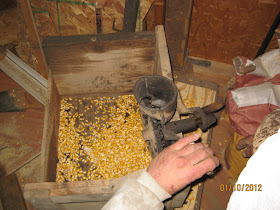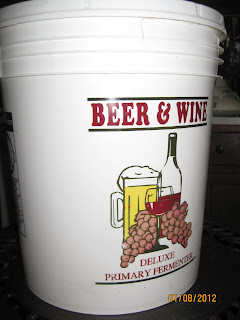 |
| Cranberry bread, a bottle of good wine, and French bread. Near Heaven! Recipes follow. |
I do believe, when someone comes in from the cold, there is nothing that warms the heart as much as the aroma of freshly baked bread. Then, add a glass of wine, and who can tell what may follow!
I offer ONE recipe that I follow precisely: a basic French bread from the Sedgewood Book of Baking, Sedgewood Press 1983. I can't get over how nicely it turned out, how deliciously nutty the flavor, and how amazing its texture! Honestly, I was blown away by it! I didn't expect such a pleasingly sensuous experience!
 |
| Plan several minutes of kneading time. |
 |
| It is labor intensive, a great workout for upper body! |
 |
| Divide the French dough into three sections and shape. This photo shows a work in progress. |
 |
| Voila! I can do it and so can you!!! |
|
|
|
I think we get so used to tasteless, textureless breads that we forget how good food used to be! Let's bring it back! Try these recipes. They're not hard to do, and you too will get delicious and nutritious results!
Sedgewood's FRENCH BREAD
2 pkgs active dry yeast
2 tsp sugar
2 1/4 cups warm water (105 to 115 degrees F)
6 1/2 to 7 cups all-purpose flour
1 T salt
cornmeal
1. Place yeast and sugar into large mixing bowl. Add warm water and stir until yeast and sugar are dissolved. Let stand 5 to 10 minutes or until foamy. [This is called "the bloom", and it's very important when using yeast to include this time for the yeast to go into action.]
2. Add 2 cups flour and the 1 T salt to bowl. Stir with wooden spoon until smooth. Stir in as much remaining flour as possible, 1 cup at a time, to make stiff dough.
3. Place dough on lightly floured surface and knead in as much flour as necessary to make fairly stiff dough. Continue kneading about 8 to 10 minutes or until dough is smooth and elastic. Place dough in greased bowl and turn to coat entire surface. Cover with clean towel and let rise in warm, draft-free place for about 1 to 1 1/2 hours or until doubled in bulk.
4. Grease a large cookie sheet and lightly sprinkle cookie sheet with cornmeal. Punch dough down and place on lightly floured surface. Knead dough 2 minutes. Cut dough into three equal-size pieces. Shape each piece into a roll, about 10 inches long, tapering ends of each roll. Pinch ends to seal. Place on prepared cookie sheet, spacing them about 3 inches apart. Lightly brush each loaf with cold water. Cover and let rise in warm, draft-free place about 1 hour or until loaves are doubled in bulk.
5. Pre-heat oven to 425 degrees F. Uncover the loaves and cut 3 or 4 diagonal slashes across top of each loaf with a very sharp knife. Place large, shallow baking pan, half filled with water on bottom rack of oven. Bake loaves 35 to 40 minutes or until loaves are lightly browned and sound hollow when tapped on the bottom. Bursh or spray loaves with water every 10 minutes of baking to give bread a nice hard crust.
(The Sedgewood Book of Baking can be found used for a reasonable price from Alibris and Amazon. It has wonderful tips for the novice baker!)
My gluten-free cranberry bread is loosely based on a
packaging recipe of Hodgson Mill's All Purpose Gluten Free Baking Flour but, for this bread, I
used various ingredients and methods for a yummy and different result and, again, the flavor and texture were like magic!
ZESTY CRANBERRY BREAD
(shown in top photo, on the left)
2 1/2 cups Hodgson Mill All Purpose Gluten Free Flour
3/4 cup granulated sugar
2 T Hodgson Mill Organic Milled Flax Seed
1 T baking powder
1 1/2 tsp xanthum gum
1 cup sweetened dried cranberries
1/4 cup dried currants
2 large eggs, room temp
3/4 cup milk
2 T vegetable oil
2 T butter, melted
1 tsp vanilla
1 tsp salt
1. Blend dry ingredients together in a bowl. Add the cranberries and currants. Set aside.
2. In a mixer bowl, beat eggs on low for 30 seconds. Add milk, oil, vanilla and salt. Mix well on medium speed.
3. Remove bowl from mixer. Pour dry ingredients into eggy batter. Mix with a large spoon until just blended. Pour batter into small pie pans and mound up the center slightly.
4. Bake at 375 degrees F for about 20 minutes until tops are golden. Remove from heat and cool on wire rack. Brush tops with melted butter. YUM!!!
(This is a recipe that makes a bread that is moist and delicious. It can also be made into muffins.)
Questions: Either homemade or not, what delectable breads have you tried lately? And are you looking for any recipes?




















































